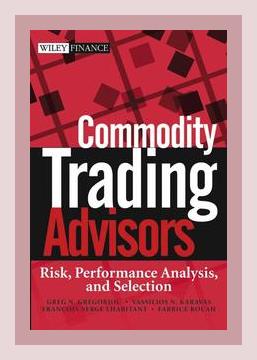Finance, Economics, Trading, InvestingTrading and Technical Analysis
Introduction
“Commodity Trading Advisors: Risk, Performance Analysis, and Selection” by Greg N. Gregoriou is a comprehensive guide that delves into the intricacies of Commodity Trading Advisors (CTAs). The book offers readers a deep understanding of the risk management strategies, performance evaluation methods, and the critical factors that should be considered when selecting a CTA. With the growing interest in alternative investments, this book serves as a crucial resource for both novice and experienced investors seeking to navigate the complexities of managed futures. The hook lies in its detailed analysis and practical insights, making it an indispensable tool for those looking to diversify their portfolios with CTAs.
Section 1: Understanding Commodity Trading Advisors (CTAs)
The book begins by providing a thorough introduction to Commodity Trading Advisors, explaining their role in the financial markets. CTAs are professional money managers who use futures contracts to achieve their investment objectives. The author explains that CTAs have gained popularity due to their ability to deliver non-correlated returns, making them a valuable addition to a diversified portfolio.
- Example 1: Gregoriou highlights the historical context of CTAs, explaining how they emerged as a response to the limitations of traditional investment strategies during periods of market volatility.
- Example 2: A detailed case study is presented on how CTAs performed during the 2008 financial crisis, showcasing their resilience and ability to generate positive returns when traditional assets were plummeting.
Memorable Quote: “The true value of a CTA lies not in its ability to outperform the market, but in its capacity to provide diversification benefits that can mitigate overall portfolio risk.”
Section 2: Risk Management Strategies Employed by CTAs
Risk management is at the core of CTA strategies, and Gregoriou dedicates a significant portion of the book to exploring the various techniques used by CTAs to manage risk. The book covers topics such as position sizing, leverage, and the use of stop-loss orders.
- Example 3: The author provides an in-depth analysis of the Turtle Trading experiment, where a group of novice traders, using a predefined set of rules, successfully managed risk and generated substantial returns under the guidance of seasoned traders.
- Example 4: Gregoriou also discusses the use of trend-following strategies, explaining how CTAs use historical price data to identify and capitalize on market trends while controlling downside risk.
Memorable Quote: “In the world of commodity trading, managing risk is not just about avoiding losses—it’s about positioning oneself to capture opportunities in the face of uncertainty.”
Section 3: Performance Analysis of CTAs
Performance analysis is another critical aspect covered in the book. Gregoriou emphasizes the importance of understanding the metrics used to evaluate CTA performance, such as the Sharpe ratio, Sortino ratio, and maximum drawdown.
- Example 5: The book provides a comparative analysis of several CTAs, illustrating how different performance metrics can lead to varying conclusions about a CTA’s effectiveness.
- Example 6: Gregoriou also explores the concept of survivorship bias in performance analysis, warning readers about the pitfalls of relying solely on historical performance data without considering the impact of funds that have failed and are no longer part of the dataset.
Memorable Quote: “Evaluating a CTA’s performance requires more than just looking at past returns; it demands a comprehensive understanding of the risk taken to achieve those returns.”
Section 4: Selection Criteria for Choosing a CTA
Selecting the right CTA is a crucial decision for any investor, and Gregoriou provides a detailed guide on the factors that should be considered during the selection process. He discusses the importance of understanding a CTA’s trading philosophy, track record, fee structure, and risk management practices.
- Example 7: The book includes a practical checklist for investors to use when evaluating potential CTAs, covering aspects such as transparency, regulatory compliance, and alignment of interests between the CTA and its investors.
- Example 8: Gregoriou also examines the role of third-party due diligence firms in the selection process, highlighting their ability to provide an objective assessment of a CTA’s operations and performance.
Section 5: The Role of CTAs in a Diversified Portfolio
In the final section of the book, Gregoriou discusses the role of CTAs within the broader context of a diversified investment portfolio. He explains how CTAs can provide diversification benefits due to their low correlation with traditional asset classes like stocks and bonds.
- Example 9: The author presents a case study on the performance of a diversified portfolio that includes CTAs, demonstrating how the inclusion of managed futures can enhance risk-adjusted returns.
- Example 10: Gregoriou also addresses the challenges of integrating CTAs into a portfolio, such as liquidity constraints and the potential for high fees.
Conclusion
“Commodity Trading Advisors: Risk, Performance Analysis, and Selection” by Greg N. Gregoriou is a vital resource for investors seeking to understand and capitalize on the opportunities presented by CTAs. The book provides a comprehensive overview of the strategies employed by CTAs, the methods for evaluating their performance, and the critical factors to consider when selecting a CTA. As the interest in alternative investments continues to grow, Gregoriou’s insights remain relevant, offering valuable guidance for those looking to enhance their portfolios with managed futures. The book’s impact is significant, as it not only educates readers on the complexities of CTAs but also equips them with the tools necessary to make informed investment decisions in an increasingly uncertain financial landscape.
Finance, Economics, Trading, InvestingTrading and Technical Analysis
